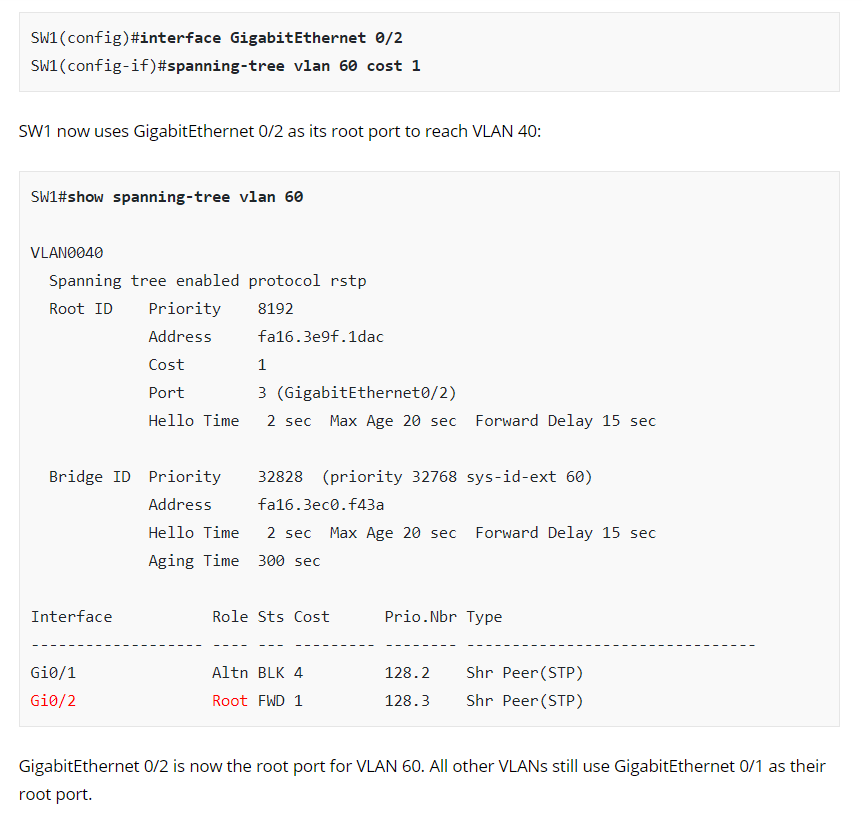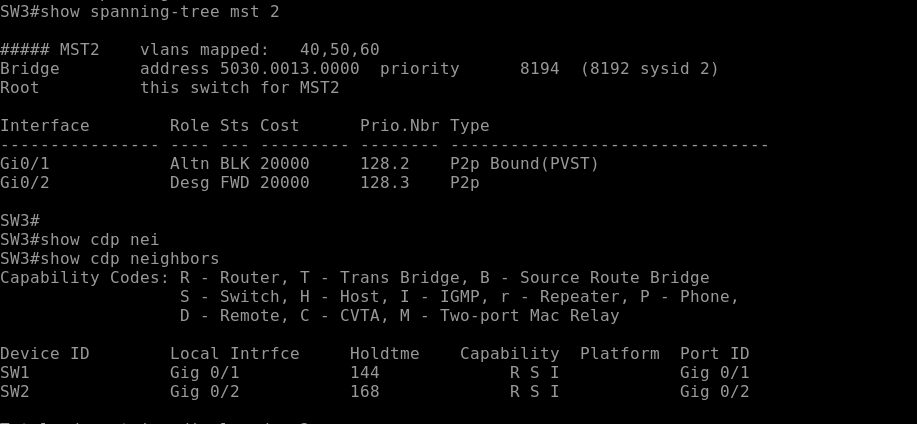This topic is to discuss the following lesson:
PVST+ calculates an instance for each spanning-tree instance.
PVST+ calculate a stp instance for each vlan ? RIGHT?
Hello Stefano.
PVST+ as its name suggests creates an spanning tree instance for EACH VLAN. MST on the other hand can have many VLANs participate in a single spanning tree instance thus reducing the number of spanning tree instances and thus consuming fewer system resources (CPU, Memory etc).
I hope this has been helpful!
Laz
So is this the same methodology between between connecting switches that do say RSTP and PVRST? Say I want to connect a non-Cisco switch to a Cisco model. Would the same lessons detailed here be valid when connecting a single-instance RSTP switch to a Cisco switch that does PVRST and has one instance per VLAN?
Hello Ehsan
Essentially, PVRST uses multiple instances of IEEE 802.1w. Most non-cisco devices that support RSTP will support one instance of PVRST. In most cases, because PVRST is backward compatible with RSTP, the PVRST implementation will revert to RSTP. So you are essentially correct in your descsription.
I hope this has been helpful!
Laz
Thank you very much Lazaros!
Hi Rene,
In the video example, why did SW3 choose to have SW2 as its root where SW1 in the PVST+ is root ? Did it have to follow MST root port ?
Thanks,
M
Hello Madhu
Can you please clarify at which point in the video this situation takes place? Also, if the same is found in the lesson text, please specify the location so we can look more closely at it and so that we can respond more appropriately to your question.
Thanks!
Laz
Around 21:50.
SW3 still considers SW2 to be the Root Bridge for instance 1. Which make sense, since the PVST+ switch (SW1) can only influence the MSTI0.
Hello Team,
I completed trunking to access switches, created VLANs, configured MST on 2 Instances and put VLANs on Instance 1 and Instance 2. I put priority of 8192 on MST 0-1 on Switch 2 to make it Root Bridge.
After that, I put verification command sh spanning-tree vlan 10, sh spanning tree mst 1, these commands did not worked.
Some verification commands like sh spanning-tree vlan 1 and sh spanning-tree mst 0 were working. Any suggestions?
PS: I am using IOSvL2 switch.
Kind Regards,
Jimmy
Hello Jimmy
When you say these commands didn’t work, do you mean they didn’t output anything at all or they didn’t output what you expected? If there was no output, then the specific VLAN or instance, is simply not running, and there is an issue with the configuration.
If these commands were outputting the correct information, then you will have to take a look at the configuration of VLAN 10 and of MST 1. Check to make sure that your MST instances are configured correctly. It may help if you share with us a little more specific information so that we can guide you in more detail.
I hope this has been helpful!
Laz
Hello Laz,
Running configuration looks fine:
spanning-tree mst configuration
name REGION1
revision 1
instance 1 vlan 10, 20, 30
instance 2 vlan 40, 50, 60
!
spanning-tree mst 0-1 priority 8192
MST Instance 1 has VLAN 10 and Instance 1 has given priority of 8192.
When I try to verify it with sh spanning-tree mst 1, there is an output that says,
No mst information available for instance(s) 1
Hello Jimmy
I’m not sure if you did this, you don’t mention it in any of your posts, but another reason for this to occur is that you don’t have any active interfaces added on the particular VLANs. For example, for instance 1, you must have at least one active interface on VLAN 10, one on VLAN20, and one on VLAN 30, (or have all the VLANs on a trunk port that is active at the time). If that is done, then you should see information about MST1 showing up.
I hope this has been helpful!
Laz
Hi Rene, Lazaros,
Could you be so kind and elaborate a little bit more on this statement: “MST only uses PVST+ features, so there is no performance difference.” ?
Does this mean that when PVRST+ domain connected to an MST domain - there is no proposal/agreement mechanism on the links interconnecting them and the interoperability is timers based?
Thank you in advance.
Hello Nurlan
Yes, you are correct. When MST interoperates with PVRST+ it reverts to operating as PVST+ Since PVRST+ is backward compatible with PVST+ it operates fine. And yes, you are correct, there is no proposal agreement mechanism on the links interconnecting them. Operation is timers based just like PVST+.
I hope this has been helpful!
Laz
Is this a mistake?
- The command shows the VLAN 60 port cost being adjusted
- the next bit of text references VLAN 40
- the command says show spanning-tree VLAN 60
- the output shows VLAN 40.
I’m a bit confused by this section.
Thanks in advance,
Austin
Hello Austin
Yes you are correct, thanks for pointing this out, I will let Rene know so he can make the appropriate changes.
Laz
Greetings,
I did the same lab but noticed something that caught my attention.
If we check on SW1 it appears as Root for all Vlans created including Vlan1. But SW3 also appears as root for MST 2 whose Vlans are 40,50, and 60.
Can you help me understand how this is possible?
Neves
Hello Neves
In Rene’s lesson he states:
it is possible that two VLANs share the same MST instance but use different root bridges, root ports, and other attributes in the PVST+ domain.
This seems to be one of those cases. At what point in the lab do you see this behaviour? This will take place if the correct configuration is not implemented. Note that Rene also states:
PVST+ BPDUs for all VLANs except VLAN 1 must be identical or superior compared to the PVST+ VLAN 1 BPDU.
In your config above, the BPDUs for VLAN1 are superior to the rest, and this does not fulfil the above stated requirement. This is why you see this inconsistance.
Take a look at the steps taken in the lesson and examine the results of the commands as you apply them, and you’ll see at what point this behaviour is fixed.
I hope this has been helpful!
Laz
Hello Laz,
Thanks!
It was very useful.


